 Website:
I.T.S.
Website:
I.T.S.
Catalog excerpts
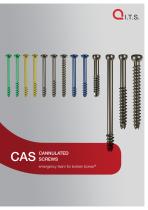
CANNULATED SCREWS emergency team for broken bones®
Open the catalog to page 1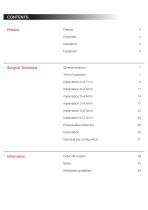
Surgical Technique Contraindications 7 Individual tray configuration 27 Information Order information 28
Open the catalog to page 2
Preface Preface: I.T.S. GmbH provides various cannulated screw types with different diameters and lengths covering a wide range of indications for fracture treatment in trauma surgery. Low-profile screw heads with small diameters help minimize soft tissue irritation and are suitable for minimally invasive methods. We offer customized equippping of surgical trays so that users can have trays put together according to their requirements and suggestions.
Open the catalog to page 3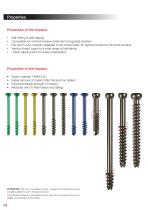
Properties Properties of the implant: • • • • • Self-drilling & self-tapping Cannulated for minimal invasive treatment and guided insertion Flat and curved washers (adapted to the screw head, for optimal contact to the bone surface) Various thread types for a wide range of indications * Back-tapping flank for easier explantation Screw material: TiAl6V4 ELI Easier removal of implant after fracture has healed Improved fatigue strength of implant Reduced risk of inflammation and allergy ATTENTION: The I.T.S. cannulated screws - except for the Dens Axis screw are not suitable for use in the...
Open the catalog to page 4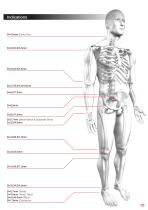
D=6.5/7.3mm D=2.7mm (distal Radius & Scaphoid Bone) D=3.5/4.0mm D=3.5/4.0/4.5mm D=2.7mm (Tarsal) D=3.5mm (Tarsal, Talus) D=4.0/4.5mm (Talus) D=7.3mm (Calcaneus)
Open the catalog to page 5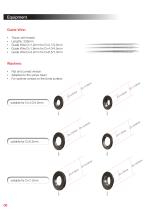
Equipment Guide Wire: • • • • • Trocar with thread Lengths: 228mm Guide Wire D=1.2mm for D=2.7/3.5mm Guide Wire D=1.6mm for D=4.0/4.5mm Guide Wire D=3.2mm for D=6.5/7.3mm Washers: • Flat and curved version • Adapted to the screw head • For optimal contact to the bone surface mm
Open the catalog to page 6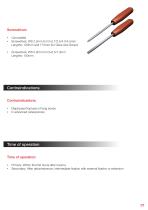
Screwdriver: • Cannulated • Screwdriver, WS 2.5mm for D=2.7/3.5/4.0/4.5mm Lengths: 120mm and 170mm (for Dens Axis Screw) • Screwdriver, WS 5.0mm for D=6.5/7.3mm Lengths: 100mm Contraindications Contraindications: • Diaphyseal fractures of long bones • In advanced osteoporosis Time of operation Time of operation: • Primary: Within the first hours after trauma • Secondary: After detumescence, intermediate fixation with external fixation or extension
Open the catalog to page 7
D=2.7mm cannulated Cortical Screw Indications: • • • • Fractures of the proximal and distal Radius Fractures of the proximal Ulna Fractures of the Scaphoid Bone Fractures of the Tarsal Optionally drilling Predrilling is possible in strong cortical bone with a drill point equal to the core diameter of the screw for easier insertion of the cannulated screw Place the spiral drill, cannulated, D=2.0mm, AO Connector over the guide wire and perform drilling under image converter. Attention: Do not drill further than the tip of the guide wire as this would impair the firm fixation of the guide...
Open the catalog to page 8
Identification of screw length Place screw depth gauge (59162) over guide wire and insert it through the soft tissue down to the bone. Then read off the required length measurement at the end of the calibrated guide wire. Optional use of washer The use of a washer is recommended in the presence of very osteoporotic bone. Through the additional bone contact surface, the screw load will be distributed across a larger area and reduce countersinking of the screw head into the osteoporotic bone.
Open the catalog to page 9
Placement of the screw Place the D=2.7mm cannulated Cortical Screw with a short variable or a variable thread (31272-XX/31277-XX) over the guide wire and insert it using the screwdriver, cannulated, WS 2.5, L=120mm (56253-120). Finally, remove the guide wire and confirm correct position under image converter.
Open the catalog to page 10
D=3.5mm cannulated Cortical Screw Indications: • Fractures of the Malleolus medialis/ lateralis • Fractures of the proximal and distal Radius and Humerus • Fractures of the proximal Ulna • Fractures of the Patella Fractures of the distal Tibia Fractures of the upper ankle Fractures of the Tarsal Fractures of the Talus Ligament fixation Optionally drilling Predrilling is possible in strong cortical bone with a drill point equal to the core diameter of the screw for easier insertion of the cannulated screw Place the spiral drill, cannulated, D=2.5mm, AO Connector over the guide wire and...
Open the catalog to page 11
Identification of screw length Place screw depth gauge (59162) over guide wire and insert it through the soft tissue down to the bone. Then read off the required length measurement at the end of the calibrated guide wire. Optional use of washer The use of a washer is recommended in the presence of very osteoporotic bone. Through the additional bone contact surface, the screw load will be distributed across a larger area and reduce countersinking of the screw head into the osteoporotic bone.
Open the catalog to page 12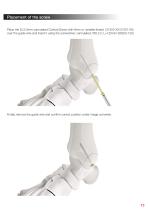
Placement of the screw Place the D=3.5mm cannulated Cortical Screw with 9mm or variable thread (31352-XX/31357-XX) over the guide wire and insert it using the screwdriver, cannulated, WS 2.5, L=120mm (56253-120). Finally, remove the guide wire and confirm correct position under image converter.
Open the catalog to page 13
D=4.0mm cannulated Cancellous Screw Indications: • Fractures of the Dens Axis • Fractures of the proximal and distal Radius and Humerus • Fractures of the proximal Ulna • Fractures of the Patella • Fractures of the distal Tibia • Fractures of the Malleolus medialis/ lateralis • Fractures of the Talus • Ligament fixation Access • Reposition manoeuvres can be practised using an external halo fixator or by the corresponding positioning on the operation table • Standard two image converters (one in the lateral, the other in a.p. path of radiation rays) • Entrance to throat spinal column has to...
Open the catalog to page 14
Temporarily fixation with K-Wire For temporarily fixation exchange the central trocar against the guide wire, steel, D=1.6mm, L=228mm, TR, with thread (35164-228). The guide wire is placed beginning at the base of the 2nd cervical vertebra up to the dens top. Attention: To avoid possible bending, insert the guide wire carefully It is to be noted however that the guide wire penetrates exactly central into the dens top. Identification of screw length After removal of the middle trocar the depth gauge is introduced. Position the depth gauge (59163) at the guide wire and lead it to the bone....
Open the catalog to page 15All I.T.S. catalogs and technical brochures
-
ufs
1 Pages
-
DHL
2 Pages
-
ITS
2 Pages
-
PHL
24 Pages
-
ACLS
20 Pages
-
CFN
32 Pages
-
OLS
24 Pages
-
PHLs
20 Pages
-
CTN - Cannulated Tibia Nail
28 Pages
-
SR Sacral Rods
20 Pages
-
HCS
24 Pages
-
TOS Twist-Off Screw
20 Pages
-
TLS
20 Pages
-
PRS-RX
32 Pages
-
HLS
20 Pages
-
ES
20 Pages
-
SR
20 Pages
-
FL
24 Pages
-
PL - Pilon Locking Plate small
12 Pages
-
OL - Olecranon Locking Plate
24 Pages
-
CAS
40 Pages
-
FCN
20 Pages
-
HOL
24 Pages
-
FLS
24 Pages
-
PFL
20 Pages
-
DTL
24 Pages
-
HTO
24 Pages
-
PTL
32 Pages
-
DFL
32 Pages
-
SCL
32 Pages
-
SLS
24 Pages
-
CAL
20 Pages
-
DUL
24 Pages
-
CLS
28 Pages



























































